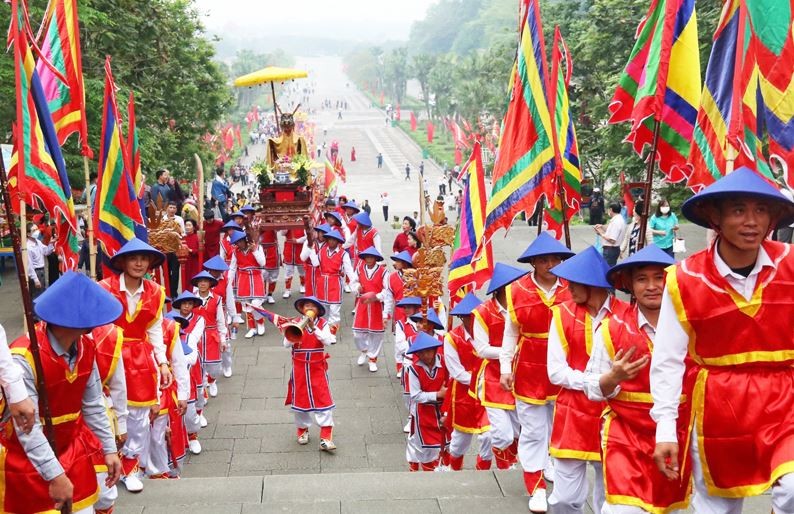Giant lotus leaves in Dong Thap’s Phuoc Kien pagoda
(VNF) - The giant lotuses that grow in the ancient pagoda of Phuoc Kien in the southern province of Dong Thap have leaves up to 3m wide and can carry a grown man weighing up to 80kg.
| |
The ancient pagoda of Phuoc Kien, Chau Thanh District in the southern province of Dong Thap, where the lotus grows miraculously large. (Photo: hanhtrangdulich)
While lotuses in the North bloom only in summer, the flower blooms in Dong Thap Province year-round. Lotuses are everywhere, but they are most prominently displayed during floating season (between August and November).
The kind of lotus in Phuoc Kien may be the most special one. Thanks to its big size, it's called King of Lotus. Local people often refer to it by the name "Lotus Pagoda" because there are many giant lotuses in the ponds.
Phuoc Kien Pagoda was established in the 18th century. It was the revolutionary base in the two wars of resistance against France and the United States. However, local people often refer to it by the name "Lotus King Temple" because there are many giant lotuses in the temple pond.
In addition to offering fruits to Buddha and monks, the local people brought goods and food to soldiers who stayed at the pagoda during the wars.
The pagoda was mostly demolished in 1966 after a U.S. bombing, and then it was rebuilt by the local people.
The temple has two lotus ponds, the small pond in front and the large pond at the back, which once the wartime bomb craters.
| |
There are many kinds of lotuses in the ponds but the most special is the one with big, thick, spiny leaves with diameters from 1.5 - 2 meters. Lotus stems are as big as adult wrists, with leaf edges of 2cm - 5cm. (Photo: luuvinhthanh)
The front face of the leaves is glossy green while the under face have many thorns and large tendons. In particular, mature leaves can "carry” a person weighing up to 80kg.
The lotus bud is white in the morning, and the flower turns pink when it's in full bloom. Then it closes and opens again the next day. Each time it blooms, its colour gets darker. The flower is dark purple when it fades.
In the dry season, lotus leaves are just 1 to 1.5 m wide but in the rainy season, they can “bloom” to nearly 3m wide. Lotus flowers bloom in 3 days, twice a day and their color continuously changes.
| |
The front face of the leaves is glossy green while the under face have many thorns and large tendons. In particular, mature leaves can "carry” a person weighing up to 80kg. (Photo: dinhkuti)
This strange kind of lotus originates from the Amazon, with the scientific name Victoria amazonica or Victoria regia. Originating from South America, it is the largest of the Nymphaeaceae family of water lilies.
Tourists should come in September and October of the lunar calendar to enjoy King Lotus. By then, the leaves are very big and thick, filling the pond surface and allowing people to stand on them. The bridge across the pond will help you stand on leaves easier.
| |
Many tourists come to the pagoda are so excited to be standing on lotus leaves. (Photo: gios_kp)
Located deep in Chau Thanh District, the pagoda is small, concealing itself under a tree canopy. Just ask the way to the Lotus Pagoda, and you will be carefully guided by the locals.
From Highway 80, you turn on quite quirky riverside roads for two-wheel vehicles only, then across a wooden bridge to get to the village gate./.
VNF
Most read
Recommended
 Travel
Travel
Experience The Unique Camping On The White Cliffs In Ha Giang
 Travel
Travel
Conquer The Majestic Putaleng Mountain In Northern Vietnam
 Travel
Travel
Discover The Legendary Son River In Quang Binh
 Travel
Travel
Suoi Tia – The Stunning Upstream Of Tuyen Lam Lake
Popular article
 Travel
Travel
Ha Long Carnaval Festival 2024 To Be Held In Vietnam
 Travel
Travel
Ly Son Island – A Perfect Getaway For A Summer Trip In Vietnam
 Travel
Travel
Vietnam Joins 27th Travel and Vacation Show in Canadian Capital
 Travel
Travel








